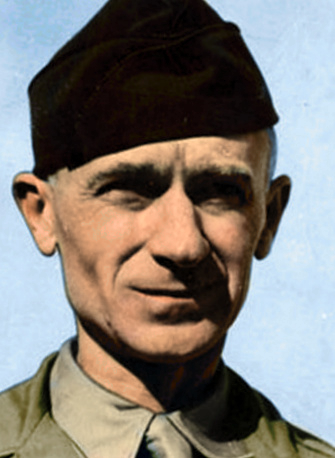
Roving Reporter
By Ernie Pyle
Before leaving for the Pacific theater of war with the Navy, Ernie Pyle visited Hollywood to look in on the picture being produced on the basis of his columns from the African and European war theaters. Ernie is reluctant to discuss the picture and has paid little attention to it, but the public’s interest in it has been keen. Therefore, he was asked to write a column dealing with his impressions of the movie version of his reporting, and it follows. This column was written before Ernie left San Francisco. Tomorrow the Press will print Ernie’s first column based on his new assignment.
SAN FRANCISCO, California – And now about the movie which is being partly based on these columns from the war fronts over the last two years.
Well, the movie is finished at last. I mean the shooting is finished. But there are a lot of things we laymen don’t know about the movies, and one of them i9s that a film isn’t ready to show for about three months after they’ve finished shooting. So, I don’t expect you’ll be seeing it till April or May.
They are still calling it The Story of G.I. Joe. I never did like the title, but nobody could think up a better one, and I was too lazy to try. There is a possibility they’ll change it.
It is a movie about the Infantry. There isn’t much of a story to it, and there’s no conventional love interest running through it.
The War Department cooperated, and furnished two companies of soldiers who were moved to Hollywood, plus lots of equipment such as trucks, tanks, guns and whatnot.
The soldiers all grew beards, and although they got awfully itchy, the boys said the girls in Hollywood sure do go for a soft flossy beard. The only tragedy was when one soldier’s beard caught fire one day, and he got pretty badly burned. I don’t know whether he got a Purple Heart for that or not.
No punches pulled
The six main soldier characters in the picture were played by professional actors. But the run-of-the-mill soldiers were played by real soldiers. As was expected, a couple of the real soldiers turned out to be “finds” as actors. By the time you see the picture, practically all the soldiers in it will be filming overseas.
I spent a week in Hollywood nosing into the picture in October, another week in December, and Hollywood people were dropping off every plane, film and stage coach that passed through Albuquerque all the time I was home.
We had Hollywood writers, directors, actors, producers, photographers and research experts by the dozen at our house. The only thing Hollywood didn’t send over to Albuquerque in search of enlightenment and advice was beautiful girls, and I guess they don’t need advice.
I still don’t know whether it will be a good picture or not, but I think it will. Certainly, there are some magnificent scenes in it, and certainly it pulls no punches in showing the mud and misery and fear of an infantryman’s life.
If it isn’t a good picture, it will not be for lack of good intentions. They have worked a year and a half of it, and spent over a million dollars. They’ve slaved to avoid “Hollywooding” it. They’ve sought, and listened to advice from men who know what war is.
They’ve had at least one veteran war correspondent there all the time. The Army has kept never less than three overseas veterans of combat out there constantly. As I left Hollywood, one of these veterans said, “I think it’s going to be a good picture. At least I think it will be the most authentic war picture ever made.”
‘Uglier than Pyle’
My own part in it is very minor, as it should be, for this is a picture about the Infantry, not about me. My part is played by Capt. Burgess Meredith.
The makeup men shaved his head and wrinkled his face and made him up so well that he’s even uglier than I am, poor fellow.
The picture was directed by “Wild Bill” Wellman, one of Hollywood’s top men. Wellman is a picturesque director, wild with enthusiasm, and everything he sees is either the greatest thing he ever saw in his life, or the worst thing. Thank goodness, he thinks this picture comes in the former category.
The picture was produced by Lester Cowan, an independent through United Artists. If it’s a lousy picture, poor Lester will have to face the wrath of about two million irate soldiers. If it isn’t a lousy picture, then he can float on air for years.
An almost anonymous person whose hand bore strongly on the picture is an old Indiana school friend of mine named Paige Cavanaugh. Being one of my closest friends, he quit whatever he was doing last spring and went to work for Lester Cowan, largely to insure, as Lester puts it, that “Cowan didn’t louse Pyle up.”
But as time went on Cavanaugh’s innate good sense began to make an impression around Hollywood, and in the end, they have leaned heavily on his judgment. Cavanaugh, being a farmer at heart, still sneers at Hollywood, but he’s got a gleam in his eye that looks permanent to me.